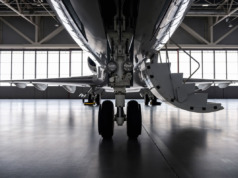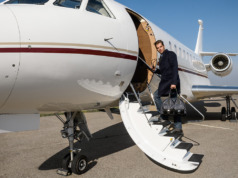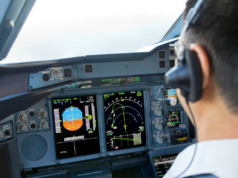
Have you ever been aboard your aircraft, and wondered whether your passenger might have forgotten to bathe?
Chances are good that body odor is not to blame for the unpleasant cabin odor. Rather, “dirty socks” is the most common descriptor in aircraft maintenance manuals for the smell of engine oil fumes that can be pumped into the cabin and flight deck through the vents above your head.
Because of the way that turbine aircraft are designed and operated, oil fumes can and sometimes do contaminate the cabin ventilation air supply, whether because of a failed or imperfect engine oil seal, a ruptured line, or an over-filled oil or hydraulic fluid reservoir. And that poses several health risks to you, your passengers, and flight crew.
Filtering the air you breathe in flight is challenging, because it enters the aircraft through engine intakes, moving at speeds up to 500 mph, and is then bled off into the cabin. The first stage engine compressor accelerates the air even further – there’s no paper or fabric filter that could withstand that pressure. Consequently, all turbine aircraft use centrifugal water (cyclonic) filtration systems, spinning the incoming air and particulates with water condensation, which is then expelled from the aircraft. While this system catches most large particulate matter, it will not catch either fumes or smaller particles. Ensuring a clean ventilation system requires more filtration down stream.
Most engine oils and fluids today are synthetics, complex chemical mixtures expertly designed to lubricate moving parts and reduce wear. They are specifically formulated to withstand the conditions in an operating aircraft engine. But these synthetics are not intended for human consumption. Concerns about the safety and health implications of breathing these fumes inflight has been mounting since the 1950s, when these “fume events” began to be documented on nearly every type of aircraft, including business jets.
The presence of malodorous oil fumes coming from the air supply vents needs to be addressed prior to departure. This is because the oils contain 2-5% organophosphate toxins, and the fumes likely will contain carbon monoxide, both of which are beyond the cyclonic filtration system’s capabilities.
And unfortunately, the only sensors currently onboard are the noses of every person on the aircraft.
The risk of experiencing acute symptoms caused by breathing oil fumes is generally recognized, given the various irritant compounds such as formaldehyde and acrolein, plus carbon monoxide, in such fumes. Those symptoms initially include irritated eyes and sinuses, later followed by dizziness, disorientation, headache, fatigue, and slowed reflexes from extended exposure, none of which are conducive to conducting business or meeting family upon arrival.
Additionally, a still-applicable 2004 Airworthiness Directive by the Federal Aviation Administration (FAA) described inflight exposure to oil fumes as an “unsafe condition,” because inhaling oil fumes can “impair the operational skills and abilities of pilots.”
These same flight safety concerns have been echoed by many accident investigators, in addition to industry safely organizations. Long-term neurological symptoms also have been documented globally after onboard exposure to oil fumes. Because the onset of symptoms – such as chronic deficits in memory, speech, concentration, and balance – typically can be delayed by one to two weeks post-exposure, you may not think to associate your failing memory with the foul smell in the cabin two weeks earlier.
So what can you do to help protect you, your crew, and your passengers from the potentially serious impact of exposure to oil fumes onboard?
The answer to this question is fourfold.
1 If You Smell Something, Say Something – Pay close attention to your immediate environment. Learn what you can ignore and what you can’t. More often than not, oil in your cabin air supply will smell bad but will not be visible, so don’t wait for smoke or haze to get your attention. Oil fumes sometimes are described as smelling “oily”, but more typically they are described as the aforementioned “dirty socks,” “smelly feet,” “musty, moldy or foul odor,” or “wet dog.” If you smell something unusual and unpleasant on the ground, direct your crew to stop departure procedures and quickly ascertain the apparent source.
Are the fumes coming from the air supply vents? If there’s either an obvious source in the cabin, or an obvious source outside the cabin (like a deicing operation), then it’s not likely to be oil. And while odor is subjective, it does provide some useful insights. Be aware that oil fumes can smell electrical, so if there’s no obvious electrical source, your maintenance crew also should troubleshoot the bleed air system. Hydraulic fluid fumes also can contaminate the air supply. They too are toxic, but not as toxic, and their distinctive acrid odor makes them easier to recognize.
2 Use Oxygen – If you have reason to believe you are breathing oil or hydraulic fumes while in flight, then you, your passengers, and flight crew should start breathing oxygen through the drop-down masks over each seat. If the pilots can’t isolate the source, they should land the aircraft as soon as safe and practicable.
3 Prevent Rather Than Remediate – Before you fly, direct your aviation manager to be sure that your maintenance technician has defined and implemented procedures to prevent over-filling of the engine oil and other fluid reservoirs, and that he or she inspects aging parts more frequently than recommended. Those cabin smells often are a result of failing oil seals in the engine compressor module, allowing oil to leak into the compressor air path, thus contaminating the air bled into the cabin. Evidence of such failure may be an oil film just behind the fan in the first stage compressor. Frequent examinations of the engine inlet will enable technicians to identify and replace bad seals before you experience problems with your cabin air.
4 Use Your Influence – Reducing or avoiding oil fumes ultimately will depend upon as-yet-undeveloped engineering solutions – like sensors, filters, and less toxic oils. For example, sensors in the bleed air stream could provide an early warning of relevant contamination and enable pilots to more efficiently locate and isolate the source of the contaminants. Less toxic aviation oils already have been under production for years in France, but need market and regulatory pressure to find acceptance and regulatory approval in the U.S. and elsewhere. Promote the need for engineering solutions to ensure clean supply air with 10,000 other corporate and individual aircraft owners and operators in the National Business Aviation Association, (www.NBAA.org), a 68-year-old business aviation advocacy group based in Washington, D.C.
Until manufacturers develop better filtration systems, or newer and less toxic lubricants and fluids, it’s up to you and your flight crew – and your noses – to monitor potentially hazardous cabin air pollution, and so, to fly safely. BAA
Judith Anderson is an Industrial Hygienist on staff with a major flight attendant union (AFA-CWA, AFL-CIO) since 1999. She researches health issues in the aircraft cabin, including oil fumes, pesticides, contaminated employee uniforms, and radiation.




